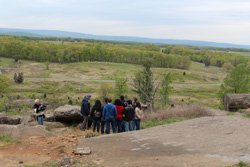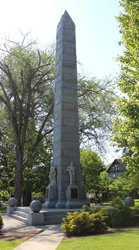Heroes without Headlines: The Bivouac of the Dead, Memorial Day 2012
Written by Tony Mussari
Photographs by Kitch Loftus-Mussari
Copyright 2012
Mussari-Loftus Associates
The Face of America Project
faceofamericawps.com
On fame’s eternal camping ground
Their silent tents to spread,
And glory guards, with solemn round
The bivouac of the dead. Theodore O’Hara
Gratitude, Honor, Respect
On this day we remember the men and women who gave their lives in service to our country. This day of national gratitude, honor and respect was first observed after our tragic Civil War. In 1868 it was called Decoration Day. Today we know it as Memorial Day.
was first observed after our tragic Civil War. In 1868 it was called Decoration Day. Today we know it as Memorial Day.
At dawn we lowered our flags to half-staff to memorialize the 1,317,764-plus men and women who have died in military conflicts in American history. At noon, we will lift the flags to full-staff to symbolize that their sacrifice was not in vain.
Recently, Kitch and I visited Gettysburg, the site of the greatest and most defining battle of the Civil War. We went there with ten students from North Plainfield High School in New Jersey and six of the adults who helped to make the trip possible.
For two days we immersed ourselves in the history and significance of the most visited battlefield in the United States. We wanted to make history come alive for the students. In so doing, we believed they would learn some important things about life.
One of the most poignant moments of the visit happened on Little Round Top. We were standing on the rocks overlooking the beautiful and vast expanse below. You could almost hear the sights and sounds of the battle as Bruce Rice, our licensed battlefield tour guide, was explaining the unfathomable loss of life and suffering that produced 51,000 casualties in three days. Something he said evoked the words William C. Oates used to document what happened here:
“The blood stood in puddles in some places on the rocks.”
That haunting word picture gave new meaning to words like bravery, courage, honor, love of country, loss, and sacrifice. Words that are frequently used in situations like this, but are seldom, if ever, fully understood.
Most of the soldiers, who fought, died and were injured at Gettysburg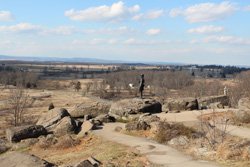 sanctified places like Devil’s Den, the Wheat Field, the Peach Orchard, Little Round Top, Cemetery Ridge, Cemetery Hill and Culp’s Hill. For the most part, they were young, and they believed in their cause. The story of this battle and the soldiers who fought it is preserved in memorable ways in this 6,000 acre national treasure. There are almost 2,000 monuments in the Gettysburg National Military Park. It is so alluring, so beautiful, so big, so intriguing and so sad; it makes an indelible impression on one’s subconscious that keeps calling you back to the holy ground so artfully described by Barbara Platt in her book appropriately titled, This is Holy Ground.
sanctified places like Devil’s Den, the Wheat Field, the Peach Orchard, Little Round Top, Cemetery Ridge, Cemetery Hill and Culp’s Hill. For the most part, they were young, and they believed in their cause. The story of this battle and the soldiers who fought it is preserved in memorable ways in this 6,000 acre national treasure. There are almost 2,000 monuments in the Gettysburg National Military Park. It is so alluring, so beautiful, so big, so intriguing and so sad; it makes an indelible impression on one’s subconscious that keeps calling you back to the holy ground so artfully described by Barbara Platt in her book appropriately titled, This is Holy Ground.
Far Out and Beyond
You will find the names of Civil War veterans inscribed on monuments in lesser known cities and towns across our commonwealth and our country. In fact, three women from Boalsburg, a small town in central Pennsylvania, are given credit for starting the national observance of Decoration Day.
In Danville, PA, 110 miles north of Gettysburg, a three-acre Memorial Park features an impressive 73 foot stone obelisk called Soldiers Monument. It was dedicated on Memorial Day in 1908. It features four statues that celebrate the soldiers who fought in the civil war.
One of the most compelling figures of a Civil War soldier stands on a platform above a bronze marker engraved with these words in Latin:
O Fortunata Mors
Quae
Naturae Debita
Pro
Patria Est Potissimun
Dr. Richard Loomis tells me the accurate translation of this historic tribute is: “O fortunate death which, due to nature, is most preferably paid for one’s native country.” 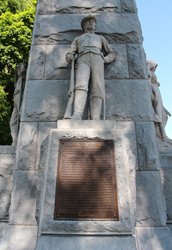
On another side of the obelisk, a statue of a goddess stands on a platform above the tribute: In memory of the soldiers and sailors of Montour County who fought for the preservation of the Union.
The marker on the third side of the obelisk records two dates: 1861 and 1865.
The title of the marker on the fourth side of the base of the obelisk reads: Lincoln at Gettysburg. The Gettysburg Address is engraved below this title.
Monuments to those who served in the Spanish American War, World War I, World War II, Korea and Vietnam are prominently displayed in other parts of the memorial park.
Who is Thomas Moore?
Wilkes-Barre, PA, is nestled between the Appalachian Mountains along the 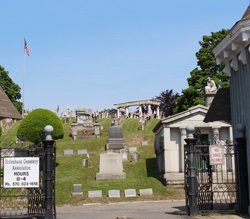 Susquehanna River, 145 miles north of Gettysburg. One section of the city is dedicated to Civil War generals. The centerpiece of this neighborhood is the GAR Memorial High School located between Grant and Sherman Streets.
Susquehanna River, 145 miles north of Gettysburg. One section of the city is dedicated to Civil War generals. The centerpiece of this neighborhood is the GAR Memorial High School located between Grant and Sherman Streets.
The Hollenback Cemetery in Wilkes-Barre has a picturesque Civil War memorial. Located on the top of the highest hill in the cemetery, the memorial was financed by the local chapter of The Grand Army of the Republic and erected in 1918 by “General Hancock’s Circle No. 9, L of the GAR”.
While visiting this site, I discovered a tombstone. It had a GAR marker supporting an American flag. The inscription on the marker read:
“Thomas Moore SCT 3RD PA HA 152 ND PENN. VOLS.” 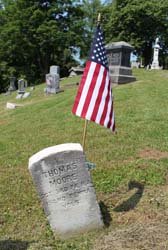
My eyes were drawn to this headstone, and my mind was filled with questions. Who was this man? When did he enter the Union Army? Did he fight at Gettysburg? Was he a Gettysburg casualty or survivor? These are questions without answers. They are similar to questions I had when Kitch and I visited a cemetery in western Pennsylvania.
There we found bronze flag supports for Confederate and GAR soldiers.
When noon approaches, we will follow protocol and raise the flags flying over Windsor Park to full-staff. When we do that, we will think about the private moments of honor and remembrance we experienced during our Face of America journey in Lafayette, California, at The Middle East Conflicts Wall Memorial in Marseilles, Illinois, the Vietnam Memorial in Emmet Park Savannah, Georgia, The Citadel in Charleston, South Carolina, the College 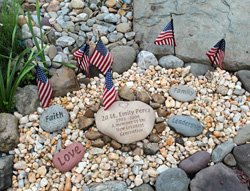 of the Ozarks in Point Lookout, Missouri, Mount Rushmore, South Dakota and the unforgettable evening ceremony honoring veterans of all wars,the Gettysburg National Military Park and the cemetery at the United States Military Academy at West Point.
of the Ozarks in Point Lookout, Missouri, Mount Rushmore, South Dakota and the unforgettable evening ceremony honoring veterans of all wars,the Gettysburg National Military Park and the cemetery at the United States Military Academy at West Point.
We will honor the 3 P.M. moment of silence, and we will give thanks for the service of every veteran we know, every veteran who has served our country and every veteran who has passed on to receive their eternal reward.
We will end this Memorial Day with a visit to the hand crafted memorial for our inspiration 2d LT. Emily Perez. There we will recite the final two stanzas of Theodore O’Hara’s poem The Bivouac of the Deadin:
Rest on embalmed and sainted dead!
Dear as the blood ye gave;
No impious footstep here shall tread
The herbage of your grave;
Nor shall your glory be forgot
While Fame her record keeps,
For honor points the hallowed spot
Where valor proudly sleeps.
Yon marble minstrel’s voiceless stone
In deathless song shall tell,
When many a vanquished ago has flown,
The story how ye fell;
Nor wreck, nor change, nor winter’s blight,
Nor time’s remorseless doom,
Can dim one ray of glory’s light
That gilds your deathless tomb.
Thank you for your service to America. God bless you, and God bless America.
Please provide feedback to:
tony.mussari@gmail.com
